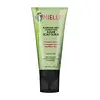What's inside
What's inside
 Key Ingredients
Key Ingredients

No key ingredients
 Benefits
Benefits

 Concerns
Concerns

 Ingredients Side-by-side
Ingredients Side-by-side

Sodium Chloride
MaskingSodium Laureth Sulfate
CleansingWater
Skin ConditioningButylene Glycol
HumectantCocamide Mea
EmulsifyingGlyceryl Stearate
EmollientParfum
MaskingHydrated Silica
AbrasivePEG-100 Stearate
Phenoxyethanol
PreservativeSaccharide Isomerate
HumectantBisabolol
MaskingMenthyl Lactate
MaskingBenzyl Salicylate
PerfumingLinalool
PerfumingLimonene
PerfumingPrunus Amygdalus Dulcis Oil
Skin ConditioningCitronellol
PerfumingHexyl Cinnamal
PerfumingFarnesol
PerfumingCitric Acid
BufferingSodium Citrate
BufferingSodium Chloride, Sodium Laureth Sulfate, Water, Butylene Glycol, Cocamide Mea, Glyceryl Stearate, Parfum, Hydrated Silica, PEG-100 Stearate, Phenoxyethanol, Saccharide Isomerate, Bisabolol, Menthyl Lactate, Benzyl Salicylate, Linalool, Limonene, Prunus Amygdalus Dulcis Oil, Citronellol, Hexyl Cinnamal, Farnesol, Citric Acid, Sodium Citrate
Sucrose
HumectantSorbitol
HumectantSodium Methyl 2-Sulfolaurate
CleansingDisodium 2-Sulfolaurate
CleansingCocamidopropyl Betaine
CleansingWater
Skin ConditioningGlycine Soja Oil
EmollientGlyceryl Caprylate/Caprate
EmollientRosmarinus Officinalis Leaf Oil
MaskingMentha Piperita Oil
MaskingBiotin
AntiseborrhoeicButyrospermum Parkii Butter
Skin ConditioningParfum
MaskingPhenoxyethanol
PreservativeEthylhexylglycerin
Skin ConditioningIngredients Explained
These ingredients are found in both products.
Ingredients higher up in an ingredient list are typically present in a larger amount.
Parfum is a catch-all term for an ingredient or more that is used to give a scent to products.
Also called "fragrance", this ingredient can be a blend of hundreds of chemicals or plant oils. This means every product with "fragrance" or "parfum" in the ingredients list is a different mixture.
For instance, Habanolide is a proprietary trade name for a specific aroma chemical. When used as a fragrance ingredient in cosmetics, most aroma chemicals fall under the broad labeling category of “FRAGRANCE” or “PARFUM” according to EU and US regulations.
The term 'parfum' or 'fragrance' is not regulated in many countries. In many cases, it is up to the brand to define this term.
For instance, many brands choose to label themselves as "fragrance-free" because they are not using synthetic fragrances. However, their products may still contain ingredients such as essential oils that are considered a fragrance by INCI standards.
One example is Calendula flower extract. Calendula is an essential oil that still imparts a scent or 'fragrance'.
Depending on the blend, the ingredients in the mixture can cause allergies and sensitivities on the skin. Some ingredients that are known EU allergens include linalool and citronellol.
Parfum can also be used to mask or cover an unpleasant scent.
The bottom line is: not all fragrances/parfum/ingredients are created equally. If you are worried about fragrances, we recommend taking a closer look at an ingredient. And of course, we always recommend speaking with a professional.
Learn more about ParfumPhenoxyethanol is a preservative that has germicide, antimicrobial, and aromatic properties. Studies show that phenoxyethanol can prevent microbial growth. By itself, it has a scent that is similar to that of a rose.
It's often used in formulations along with Caprylyl Glycol to preserve the shelf life of products.
Water. It's the most common cosmetic ingredient of all. You'll usually see it at the top of ingredient lists, meaning that it makes up the largest part of the product.
So why is it so popular? Water most often acts as a solvent - this means that it helps dissolve other ingredients into the formulation.
You'll also recognize water as that liquid we all need to stay alive. If you see this, drink a glass of water. Stay hydrated!
Learn more about Water